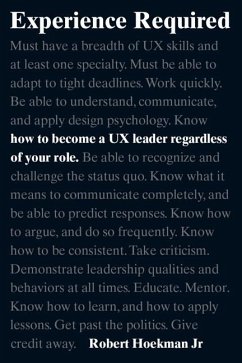24,99 €
inkl. MwSt.
Versandfertig in über 4 Wochen

12 °P sammeln
- Broschiertes Buch
- Merkliste
- Auf die Merkliste
- Bewerten Bewerten
- Teilen
- Produkt teilen
- Produkterinnerung
- Produkterinnerung
Drawing on the extensive experience of veteran UX strategist Robert Hoekman Jr and featuring the insights of several prominent design leaders, Experience Required shows students how to succeed regardless of which side of the interview table they're on or what they hope to accomplish next.
This book shows: - design instructors what they should be teaching their students for team building - students what to aspire to - hiring managers what they should look for - design directors what to expect from their teams and how to help them do it - designers what they should be doing to be effective,…mehr
Andere Kunden interessierten sich auch für
![Designing Connected Content Designing Connected Content]() Mike AthertonDesigning Connected Content36,99 €
Mike AthertonDesigning Connected Content36,99 €![CSS Selectors and Specificity CSS Selectors and Specificity]() Abdelfattah RagabCSS Selectors and Specificity29,99 €
Abdelfattah RagabCSS Selectors and Specificity29,99 €![Angular Portfolio App Development Angular Portfolio App Development]() Abdelfattah RagabAngular Portfolio App Development29,99 €
Abdelfattah RagabAngular Portfolio App Development29,99 €![Angular Portfolio App Development Angular Portfolio App Development]() Abdelfattah RagabAngular Portfolio App Development35,00 €
Abdelfattah RagabAngular Portfolio App Development35,00 €![Angular Shopping Store Angular Shopping Store]() Abdelfattah RagabAngular Shopping Store29,99 €
Abdelfattah RagabAngular Shopping Store29,99 €![CSS Typography and Web Fonts CSS Typography and Web Fonts]() Abdelfattah RagabCSS Typography and Web Fonts39,99 €
Abdelfattah RagabCSS Typography and Web Fonts39,99 €![CSS Selectors and Specificity CSS Selectors and Specificity]() Abdelfattah RagabCSS Selectors and Specificity39,99 €
Abdelfattah RagabCSS Selectors and Specificity39,99 €-
-
-
Drawing on the extensive experience of veteran UX strategist Robert Hoekman Jr and featuring the insights of several prominent design leaders, Experience Required shows students how to succeed regardless of which side of the interview table they're on or what they hope to accomplish next.
This book shows:
- design instructors what they should be teaching their students for team building
- students what to aspire to
- hiring managers what they should look for
- design directors what to expect from their teams and how to help them do it
- designers what they should be doing to be effective, to grow, to be happy, to be influential
- everyone involved that the team can do better, and how to make that happen
Hinweis: Dieser Artikel kann nur an eine deutsche Lieferadresse ausgeliefert werden.
This book shows:
- design instructors what they should be teaching their students for team building
- students what to aspire to
- hiring managers what they should look for
- design directors what to expect from their teams and how to help them do it
- designers what they should be doing to be effective, to grow, to be happy, to be influential
- everyone involved that the team can do better, and how to make that happen
Hinweis: Dieser Artikel kann nur an eine deutsche Lieferadresse ausgeliefert werden.
Produktdetails
- Produktdetails
- Verlag: New Riders
- Seitenzahl: 224
- Erscheinungstermin: 30. November 2015
- Englisch
- Abmessung: 229mm x 154mm x 17mm
- Gewicht: 308g
- ISBN-13: 9780134398273
- ISBN-10: 0134398270
- Artikelnr.: 43364180
- Herstellerkennzeichnung
- Libri GmbH
- Europaallee 1
- 36244 Bad Hersfeld
- gpsr@libri.de
- Verlag: New Riders
- Seitenzahl: 224
- Erscheinungstermin: 30. November 2015
- Englisch
- Abmessung: 229mm x 154mm x 17mm
- Gewicht: 308g
- ISBN-13: 9780134398273
- ISBN-10: 0134398270
- Artikelnr.: 43364180
- Herstellerkennzeichnung
- Libri GmbH
- Europaallee 1
- 36244 Bad Hersfeld
- gpsr@libri.de
Robert Hoekman Jr is a prolific writer and veteran UX strategy consultant. He has written hundreds of articles and several books on design topics, including Designing the Obvious, Designing the Moment, and Web Anatomy (with Jared Spool). Robert has spoken to packed rooms at web conferences all over the world. He lives in downtown Phoenix, Arizona. Learn more about him at www.rhjr.net.
Table of Contents
Preface
Chapter 1: Introduction
Key Terms
Design
Designer
User Experience (UX)
Chapter 2: The Shape of a Great Designer
Some Designer History
The Problem with Names
And Then More Showed Up
The Birth of the User Experience Designer
Design Is a Four-Letter Word
The Rebirth of the Nebulous Job Title
Unicorns: What They Are and Why You Should Be One
Unicorn = Generalist
Be Replaceable
The Upside of Overlap
Be Respectful
T-Shaped People: The Case for Specialties
Becoming a T-Shaped Person
Masquerading as a Generalist
The Depth of UX
Chapter 3: Adapting
Tools, Not Processes
Improvising
Working Quickly
Strategy Document
The Driver of the Bus
Design Time
Faster Wireframes
Faster Prototypes
Faster Usability Tests
Chapter 4: Understanding
Knowing the Psychology
They’re Smarter than You Think
They Have Other Things to Do
They Have a “Doing Mode”
They “Satisfice”
They Don’t Use Your Software the Way You
Intend Them To
They Rely on Patterns
A Million Things Are Competing for
Their Attention
They See What’s There
They Lie
They Don’t Know What’s Possible
If You Improve Their Lives, They’ll Love You
They Come With Questions
They Blame Themselves for Mistakes When They
Should Blame You
Their “Experience” Is Based on Far More than Your Website
Applying the Psychology
Talking the Psychology
Chapter 5: Questioning
Questioning Everything
Questioning Ideas
Questioning Standards
Questioning People
Questioning Your Own Work
Pushing the Profession Forward
Tipping Sacred Cows
Firing Away
Always Ask the Question
Chapter 6: Communicating
On Clear Thinking
Writing and Speaking
Thinking in Frameworks
On Writing Well
Mapping Your Message to Their Concerns
Learning to Predict the Future
Reading for Comprehension
Enabling Comprehension
Not Just What, but How and When
Do What You Can
Chapter 7: Arguing
Listening
Asking
Phases of Knowledge
Restating
Educating
Presenting
Explaining with Stories
Leading the Room
Backing It Up
Chapter 8: Leading
Staying Calm
Ignoring Distractions
Speaking Up
Taking Criticism
Being Collaborative
Hiring Well
Review the Portfolio
Google
Let Them Talk
Contract Them
Look for Unicorns
Offering Solutions Instead of Complaints
Giving Credit Away
Teaching Them to Teach
Managing Things Away from People
Creating Opportunities for Others
Choosing Teams Over Individuals
Chapter 9: Learning
How I Learned
Why Learning Matters
Leaving Your Ego Out of It
Drown a Little Every Day
Learning to Succeed, Not to Embrace Failure
Prophecies Like to Be Self-Fulfilling
Leaders Don’t Root for Failure
Repeated Failure Gets You Nowhere
What Exactly Is Success in Web Design Anyway?
Aim for the Breakthrough
Chapter 10: Being Unreasonable
The Advantage of High Standards
High Standards Lead to Prowess
High Standards Make You More Persuasive
High Standards Lead to People
Designing for Greatness
Preface
Chapter 1: Introduction
Key Terms
Design
Designer
User Experience (UX)
Chapter 2: The Shape of a Great Designer
Some Designer History
The Problem with Names
And Then More Showed Up
The Birth of the User Experience Designer
Design Is a Four-Letter Word
The Rebirth of the Nebulous Job Title
Unicorns: What They Are and Why You Should Be One
Unicorn = Generalist
Be Replaceable
The Upside of Overlap
Be Respectful
T-Shaped People: The Case for Specialties
Becoming a T-Shaped Person
Masquerading as a Generalist
The Depth of UX
Chapter 3: Adapting
Tools, Not Processes
Improvising
Working Quickly
Strategy Document
The Driver of the Bus
Design Time
Faster Wireframes
Faster Prototypes
Faster Usability Tests
Chapter 4: Understanding
Knowing the Psychology
They’re Smarter than You Think
They Have Other Things to Do
They Have a “Doing Mode”
They “Satisfice”
They Don’t Use Your Software the Way You
Intend Them To
They Rely on Patterns
A Million Things Are Competing for
Their Attention
They See What’s There
They Lie
They Don’t Know What’s Possible
If You Improve Their Lives, They’ll Love You
They Come With Questions
They Blame Themselves for Mistakes When They
Should Blame You
Their “Experience” Is Based on Far More than Your Website
Applying the Psychology
Talking the Psychology
Chapter 5: Questioning
Questioning Everything
Questioning Ideas
Questioning Standards
Questioning People
Questioning Your Own Work
Pushing the Profession Forward
Tipping Sacred Cows
Firing Away
Always Ask the Question
Chapter 6: Communicating
On Clear Thinking
Writing and Speaking
Thinking in Frameworks
On Writing Well
Mapping Your Message to Their Concerns
Learning to Predict the Future
Reading for Comprehension
Enabling Comprehension
Not Just What, but How and When
Do What You Can
Chapter 7: Arguing
Listening
Asking
Phases of Knowledge
Restating
Educating
Presenting
Explaining with Stories
Leading the Room
Backing It Up
Chapter 8: Leading
Staying Calm
Ignoring Distractions
Speaking Up
Taking Criticism
Being Collaborative
Hiring Well
Review the Portfolio
Let Them Talk
Contract Them
Look for Unicorns
Offering Solutions Instead of Complaints
Giving Credit Away
Teaching Them to Teach
Managing Things Away from People
Creating Opportunities for Others
Choosing Teams Over Individuals
Chapter 9: Learning
How I Learned
Why Learning Matters
Leaving Your Ego Out of It
Drown a Little Every Day
Learning to Succeed, Not to Embrace Failure
Prophecies Like to Be Self-Fulfilling
Leaders Don’t Root for Failure
Repeated Failure Gets You Nowhere
What Exactly Is Success in Web Design Anyway?
Aim for the Breakthrough
Chapter 10: Being Unreasonable
The Advantage of High Standards
High Standards Lead to Prowess
High Standards Make You More Persuasive
High Standards Lead to People
Designing for Greatness
Table of Contents
Preface
Chapter 1: Introduction
Key Terms
Design
Designer
User Experience (UX)
Chapter 2: The Shape of a Great Designer
Some Designer History
The Problem with Names
And Then More Showed Up
The Birth of the User Experience Designer
Design Is a Four-Letter Word
The Rebirth of the Nebulous Job Title
Unicorns: What They Are and Why You Should Be One
Unicorn = Generalist
Be Replaceable
The Upside of Overlap
Be Respectful
T-Shaped People: The Case for Specialties
Becoming a T-Shaped Person
Masquerading as a Generalist
The Depth of UX
Chapter 3: Adapting
Tools, Not Processes
Improvising
Working Quickly
Strategy Document
The Driver of the Bus
Design Time
Faster Wireframes
Faster Prototypes
Faster Usability Tests
Chapter 4: Understanding
Knowing the Psychology
They’re Smarter than You Think
They Have Other Things to Do
They Have a “Doing Mode”
They “Satisfice”
They Don’t Use Your Software the Way You
Intend Them To
They Rely on Patterns
A Million Things Are Competing for
Their Attention
They See What’s There
They Lie
They Don’t Know What’s Possible
If You Improve Their Lives, They’ll Love You
They Come With Questions
They Blame Themselves for Mistakes When They
Should Blame You
Their “Experience” Is Based on Far More than Your Website
Applying the Psychology
Talking the Psychology
Chapter 5: Questioning
Questioning Everything
Questioning Ideas
Questioning Standards
Questioning People
Questioning Your Own Work
Pushing the Profession Forward
Tipping Sacred Cows
Firing Away
Always Ask the Question
Chapter 6: Communicating
On Clear Thinking
Writing and Speaking
Thinking in Frameworks
On Writing Well
Mapping Your Message to Their Concerns
Learning to Predict the Future
Reading for Comprehension
Enabling Comprehension
Not Just What, but How and When
Do What You Can
Chapter 7: Arguing
Listening
Asking
Phases of Knowledge
Restating
Educating
Presenting
Explaining with Stories
Leading the Room
Backing It Up
Chapter 8: Leading
Staying Calm
Ignoring Distractions
Speaking Up
Taking Criticism
Being Collaborative
Hiring Well
Review the Portfolio
Google
Let Them Talk
Contract Them
Look for Unicorns
Offering Solutions Instead of Complaints
Giving Credit Away
Teaching Them to Teach
Managing Things Away from People
Creating Opportunities for Others
Choosing Teams Over Individuals
Chapter 9: Learning
How I Learned
Why Learning Matters
Leaving Your Ego Out of It
Drown a Little Every Day
Learning to Succeed, Not to Embrace Failure
Prophecies Like to Be Self-Fulfilling
Leaders Don’t Root for Failure
Repeated Failure Gets You Nowhere
What Exactly Is Success in Web Design Anyway?
Aim for the Breakthrough
Chapter 10: Being Unreasonable
The Advantage of High Standards
High Standards Lead to Prowess
High Standards Make You More Persuasive
High Standards Lead to People
Designing for Greatness
Preface
Chapter 1: Introduction
Key Terms
Design
Designer
User Experience (UX)
Chapter 2: The Shape of a Great Designer
Some Designer History
The Problem with Names
And Then More Showed Up
The Birth of the User Experience Designer
Design Is a Four-Letter Word
The Rebirth of the Nebulous Job Title
Unicorns: What They Are and Why You Should Be One
Unicorn = Generalist
Be Replaceable
The Upside of Overlap
Be Respectful
T-Shaped People: The Case for Specialties
Becoming a T-Shaped Person
Masquerading as a Generalist
The Depth of UX
Chapter 3: Adapting
Tools, Not Processes
Improvising
Working Quickly
Strategy Document
The Driver of the Bus
Design Time
Faster Wireframes
Faster Prototypes
Faster Usability Tests
Chapter 4: Understanding
Knowing the Psychology
They’re Smarter than You Think
They Have Other Things to Do
They Have a “Doing Mode”
They “Satisfice”
They Don’t Use Your Software the Way You
Intend Them To
They Rely on Patterns
A Million Things Are Competing for
Their Attention
They See What’s There
They Lie
They Don’t Know What’s Possible
If You Improve Their Lives, They’ll Love You
They Come With Questions
They Blame Themselves for Mistakes When They
Should Blame You
Their “Experience” Is Based on Far More than Your Website
Applying the Psychology
Talking the Psychology
Chapter 5: Questioning
Questioning Everything
Questioning Ideas
Questioning Standards
Questioning People
Questioning Your Own Work
Pushing the Profession Forward
Tipping Sacred Cows
Firing Away
Always Ask the Question
Chapter 6: Communicating
On Clear Thinking
Writing and Speaking
Thinking in Frameworks
On Writing Well
Mapping Your Message to Their Concerns
Learning to Predict the Future
Reading for Comprehension
Enabling Comprehension
Not Just What, but How and When
Do What You Can
Chapter 7: Arguing
Listening
Asking
Phases of Knowledge
Restating
Educating
Presenting
Explaining with Stories
Leading the Room
Backing It Up
Chapter 8: Leading
Staying Calm
Ignoring Distractions
Speaking Up
Taking Criticism
Being Collaborative
Hiring Well
Review the Portfolio
Let Them Talk
Contract Them
Look for Unicorns
Offering Solutions Instead of Complaints
Giving Credit Away
Teaching Them to Teach
Managing Things Away from People
Creating Opportunities for Others
Choosing Teams Over Individuals
Chapter 9: Learning
How I Learned
Why Learning Matters
Leaving Your Ego Out of It
Drown a Little Every Day
Learning to Succeed, Not to Embrace Failure
Prophecies Like to Be Self-Fulfilling
Leaders Don’t Root for Failure
Repeated Failure Gets You Nowhere
What Exactly Is Success in Web Design Anyway?
Aim for the Breakthrough
Chapter 10: Being Unreasonable
The Advantage of High Standards
High Standards Lead to Prowess
High Standards Make You More Persuasive
High Standards Lead to People
Designing for Greatness







